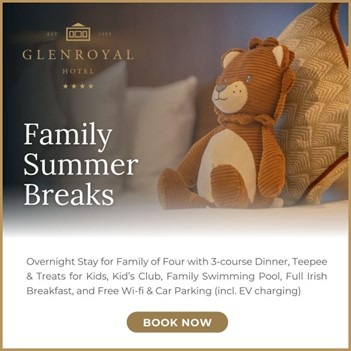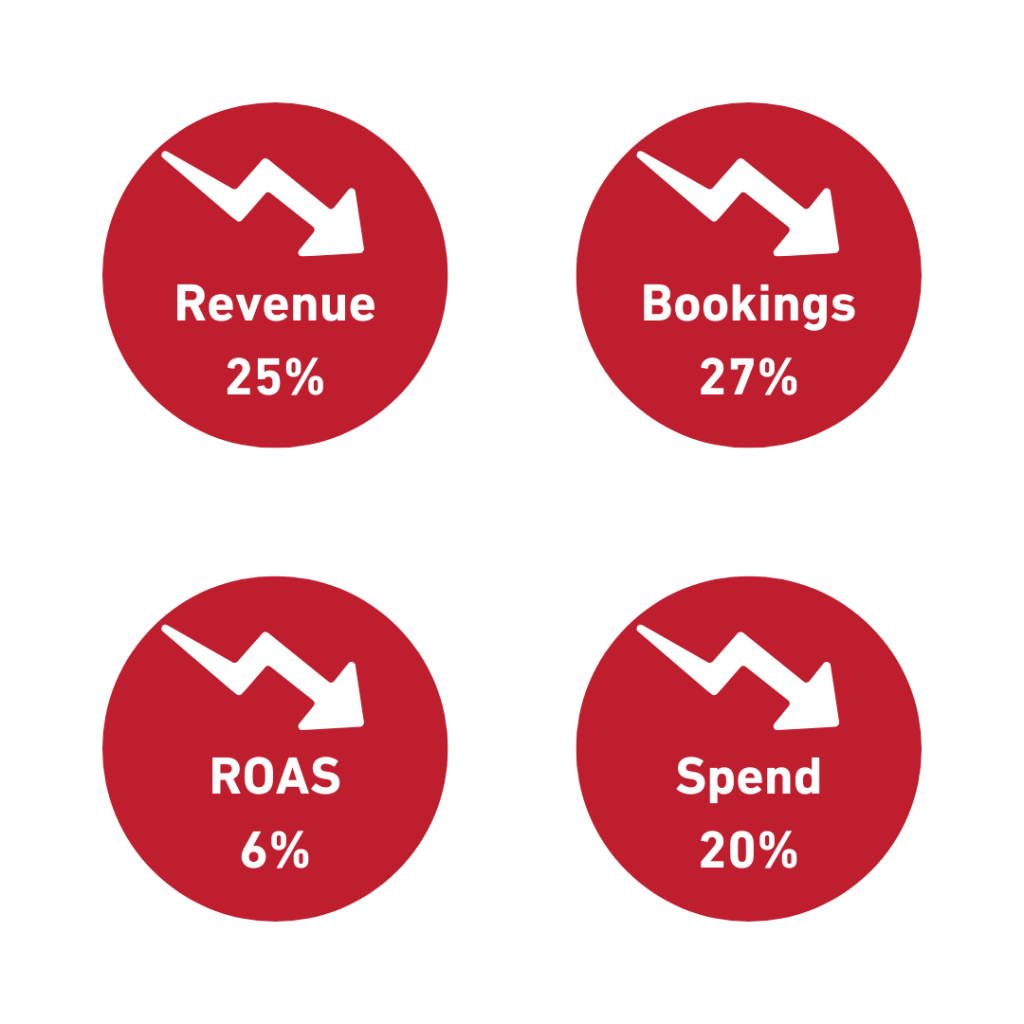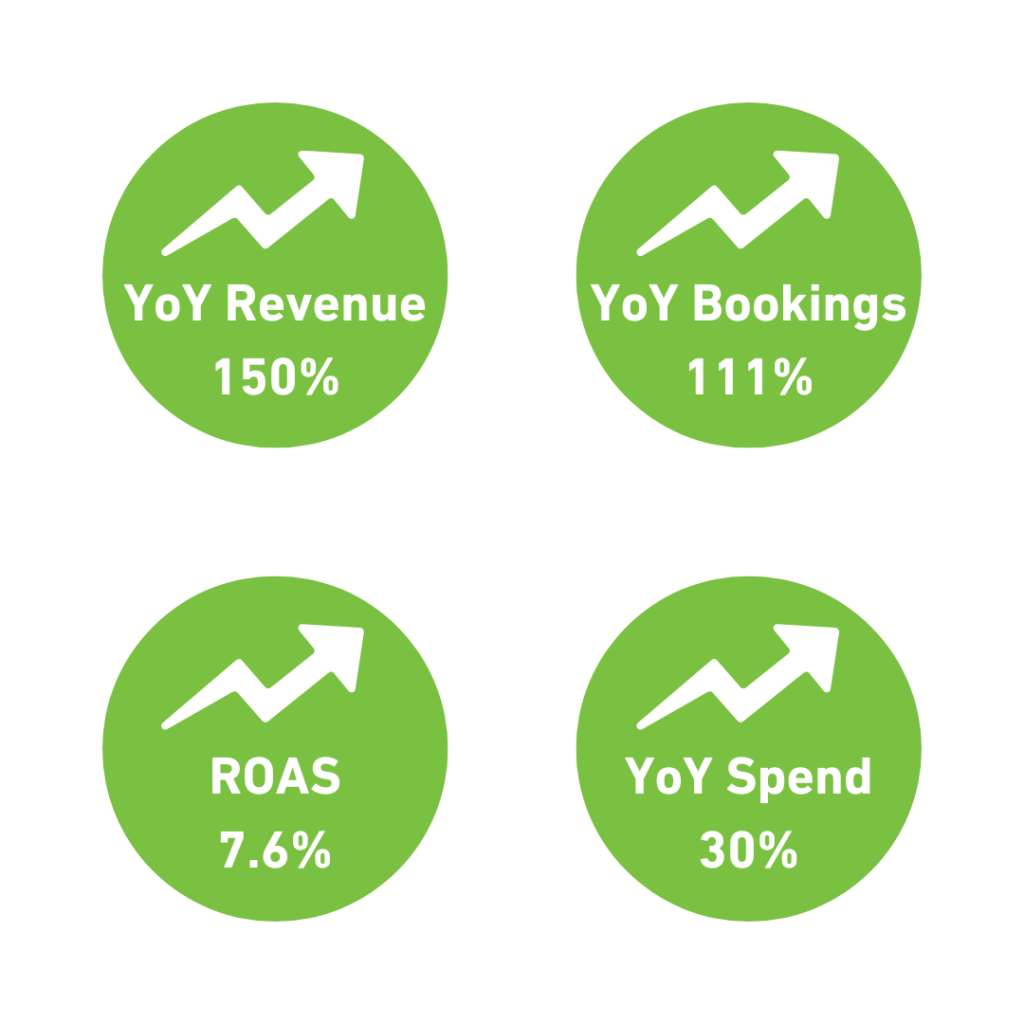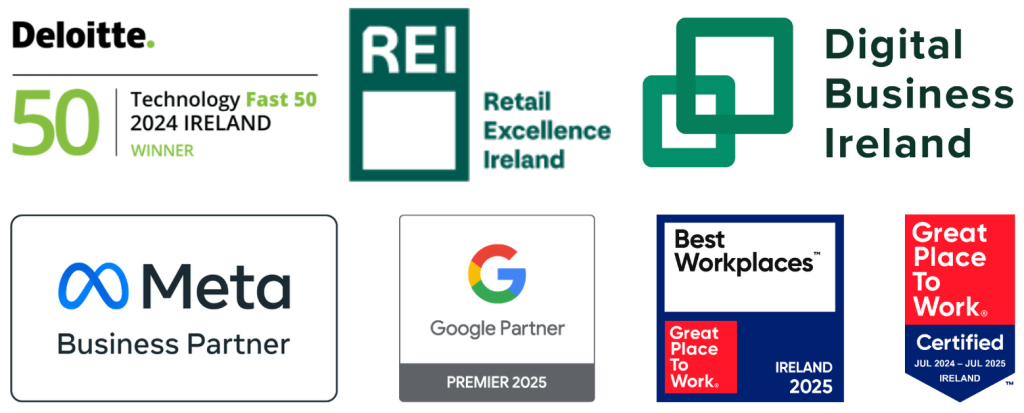Despite a challenging start to the year and broader industry headwinds, the Glenroyal Hotel & Leisure Club achieved remarkable growth through strategic paid social optimisation. Through precise audience targeting, improved creative assets, and dynamic budget management, we turned around a 25% revenue and 27% bookings decline into 150% year-over-year revenue and 111% bookings growth. This success story demonstrates how small, data-driven adjustments can deliver exceptional results, even in a demanding market environment.

At the start of the year, we saw a decline in performance compared to 2023. From January to April, revenue dropped 25.4%, bookings by 27%, spend was down 19.9%, and ROAS decreased 6.9% to 6.05. There were also external factors to deal with as hospitality and tourism across Ireland were experiencing issues including rising costs, poor weather, and cheaper alternatives abroad. As the summer approached, our goal was to reverse this trend and achieve growth through the use of paid media.
In partnership with the Glenroyal Hotel & Leisure Club, we developed a focused strategy to leverage the busy summer season and improve the year-to-date (YTD) performance. Our approach centred on refining our audience targeting, enhancing ad content, and optimising the budget. We started by analysing past performance to better understand key trends and audience behaviours.
This allowed us to fine-tune our targeting, reaching the right demographics with tailored, engaging messages. We also refreshed our ad copy and visuals, highlighting the hotel’s unique features, summer packages, and family-friendly offerings to better resonate with potential guests.
Budget-wise, we reallocated funds to prioritise high-performing channels and peak periods, ensuring maximum ROI without overspending.
This strategic approach helped turn around the YTD performance, driving more bookings and making the most of the summer demand.
Our first optimisation focused on audience segmentation and targeting. We introduced ad sets specifically for families, whose bookings have a higher average order value (AOV) and greater profitability. These new ad groups were incorporated into our three main campaigns: traffic, remarketing, and general sales, targeting both prospects and lookalike audiences. With regular customer list updates from the client, we fine-tuned our remarketing efforts, using separate lists for families and other customers. We also refined our detailed targeting to capture both high- and low-intent users.
Next, we optimised our content and ad copy strategy. Previous assets were vague, relying too much on the ad copy to convey details, which many users overlook. After consulting with the client, they updated the assets to include clear branding, unique selling points (USPs), and all necessary details. This allowed us to shorten our ad copy and use stronger calls to action (CTAs). We made sure not to run into creative fatigue and made two versions of high performing creatives such as the Emerald Park package. Finally, we optimised ad copy to be relevant to the specific audience we were targeting. This was important to ensure ads were personalised for each user.
Before

After

We adjusted our budgeting strategy, shifting focus from having a monthly spend cap, to prioritising cost efficiency and ROAS. By continuously monitoring campaign performance and results daily, we leveraged our new strategy allowing us to scale our spend and make incremental increases in budget whilst ensuring we maintained a high cost efficiency.
This flexibility allowed us to take advantage of peak periods where traffic and intent was high, such as popular concerts occurring next door in Dublin like Taylor Swift. We had the trust of our client to pull back spend in off periods where external factors were impacting bookings, for example the bad Irish weather which stopped people from travelling.

The impact of our strategy was immediate and impressive. Between May and August, revenue surged by 150%, while bookings increased by 111%. Website traffic also saw a significant uplift of 44%, and our return on ad spend (ROAS) improved by 92.9%, reaching an impressive 7.61. These results were achieved with only a modest 29.6% increase in year-over-year spending, underscoring the efficiency of our approach.
A key driver of this success was our remarketing efforts, which emphasised the power of first-party data. Out of 154 total purchasers, 99 came from our remarketing audience, demonstrating how crucial this segment was to boosting conversions. Additionally, our family-focused ad sets proved to be particularly effective. They generated 32 bookings, with an average order value (AOV) of €437, highlighting the success of targeting this segment to secure higher-value reservations.
Overall, this strategy not only helped turn around the year-to-date performance but also laid the groundwork for sustainable growth. By leveraging data-driven insights, personalised messaging, and smart budget management, we managed to maximise the summer season’s potential, setting a strong precedent for future campaigns.


Subscribe to our mailing list
Core Optimisation is a performance-based digital agency which helps you grow your online revenue. Our starting point is always you. We get to know your brand from the inside out and the outside in. If you’re interested in learning more give us a shout!



